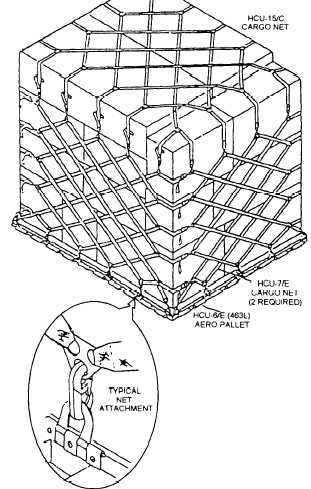weighing and marking station. Weighing and marking
procedures are outlined in the Equipment Operator,
Advanced, NAVEDTRA 12537.
Palletized Cargo
Cargo that is to be loaded on an aircraft is palletized
on 463-L air certified pallets, as shown in figure 6-25.
The weight of an empty 463-L pallet is standardized at
290 pounds; when side and top nets are added the pallet
weight is 355 pounds. These figures are to be used in
weight and balance planning of an aircraft load plan.
The outside dimensions of a 463-L pallet are 88 inches
long and 108 inches wide. The usable space on the pallet
is 84 by 104 inches; this leaves a 9-inch space around
Figure 6-25.-463-L pallet with cargo and net.
6-34
the outside perimeter of the pallet load. Cargo can be
loaded on the pallet up to 96 inches high, and the weight
limitation is 10,000 pounds per pallet maximum.
Each pallet has a total of 22 tie-down rings (six on
the long side and five on the short side) that match up
with the cargo net fasteners. 463-L pallets lock into the
aircraft by a rail on each side of the aircraft.
When loads are placed on a pallet, three point
dunnage must be placed under each pallet. The size of
the dunnage must be at least 4- by 4- by 88-inch timbers.
One timber must be placed under the center of the pallet
and one under each outside edge of the pallet; this helps
prevent warping of the pallets.
To store empty pallets, you should first put down
one set of three point dunnage, then stack the pallets no
more than 10 high. If more pallets must be stacked,
another set of dunnage must be placed on top of the first
10 pallets, then 10 more pallets can be stacked. This
sequence can be repeated up to a maximum of 40 pallets.
Each pallet must be stacked with the cargo loading
surface facing in an upward direction.
During the pallet-building process (placing cargo on
the pallets), always load heavy cargo in the center of the
pallet and build it up with lighter cargo around it. This
will keep the center of balance at the center of the pallet.
All cargo loaded on a 463-L pallet must be placed close
together with no open space between them. If space is
left between cargo items, the cargo may shift on the
pallet during flight and could cause damage to or even
loss of the aircraft.
ADVANCED BASE PLANNING
During World War II when bases were constructed
across the island chains of the Pacific Ocean, it became
apparent that significant savings in both time and
material could be realized if units of materials,
equipment, and personnel required to perform specific
functions were standardized. This was the beginning of
the Advanced Base Functional Components (ABFC)
System that is still in use today. This section will briefly
cover the ABFC System and the Facilities Planning
Guide, NAVFAC P-437.
ADVANCED BASE FUNCTIONAL
COMPONENTS SYSTEM
The Advanced Base Functional Components
System is covered in the Naval Construction Force
(NCF) Manual, NAVFAC P-315, and in volume 2 of the
Facilities Planning Guide, NAVFAC P-437. However,


